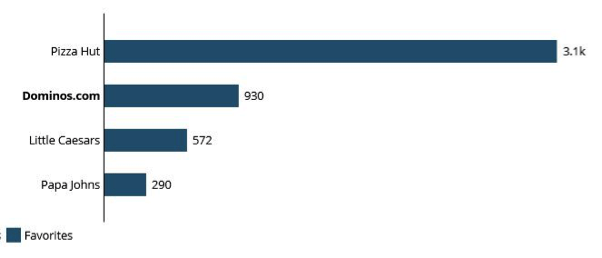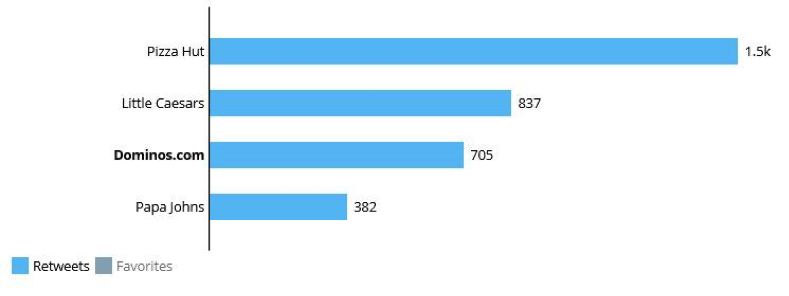Domino’s, Social Media, & Leveraging Twitter
Domino’s: a Case Study of social media and leveraging Twitter (or not)
I want to write today about Domino’s Pizza, an international franchise restaurant and pizza restaurant with delivery. Their website is https://www.dominos.com/en/ *
The company was founded by Tom Monaghan in 1960 and now has an annual volume of USD 1.8 billion and 220,000 employees worldwide. Previously the company specialized in pizza. Indeed its name was Domino’s Pizza, but then it started to also sell pasta, sandwiches, and bread —changing its name in 2012 to just Domino’s.
One reason why I have selected this company to write about is that it has a great story of success—mainly due to its capability of leveraging technology. The main strength of Domino’s has been its ability to deliver a pizza within 30 minutes after the order was placed. It was counting on its speed to deliver the pizza before that time frame for customer satisfaction. A few years ago they were offering discounts or even free pizza in the event the order was delayed more than 30 minutes—they believed in their slogan, and they stood behind the pledge.
The Mobile App
In a digital world, like the one we live in today, Domino’s has captured the importance of technology. As we know, the importance of e-commerce has been growing, and this is also true for food. Domino’s created a very advanced app and managed to have 50% of its orders now made via mobile devices—the first of its kind to have that type of success with mobile app order placement. The company even has a tracking feature that is able to tell you exactly at what point in the process your pizza is. Being a food business, it has quite a broad market. The core target market is the one related to lifestyle. Usually, families in which both parents work full time, commute more than two hours per day. They are starving after a long day at work and have very little time to dedicate to cooking. Capitalizing on the need to have the food ready, Domino’s utilized a brilliant marketing strategy by having an app that is able to track a customer’s pizza, thus making it easier to be able to order on the way home and find the pizza right on time when arriving. What a lovely feeling to be able to reach home together with a hot, delicious meal ready and waiting.
The company now tries to maintain its reputation by leveraging technology. To do this, it partnered with the creators of Apple’s Siri technology to create a voice assistant to order a pizza; the name of the assistant is Dom (get it?). In 2014 Dom was launched, and it was a huge success relative to reaching and engaging audiences and in promoting social media discussions about it.
http://industry.shortyawards.com/nominee/7th_annual/o4H/dom *
Let’s consider some Domino’s competitors:
Pizza Hut
The company link is https://order.pizzahut.com/home *
Pizza Hut, according to Wikipedia, has more than 600,000 stores in just the United States and more than 500,000 around the world. They also sell pizza, pasta, and similar food as Domino’s, and of course, they also have a big chunk of the pickup and delivery market.
Pizza Hut, according to Wikipedia, has more than 600,000 stores in just the United States and more than 500,000 around the world. They also sell pizza, pasta, and similar food as Domino’s, and of course, they also have a big chunk of the pickup and delivery market.
Papa John’s
The company link is http://www.papajohns.com/company/ *
It was founded in 1984 by John H. Schnatter. It has $1.4 billion in annual revenue and 20,000 employees. It’s mostly a takeout and delivery business, but in a few locations, it also has some places to sit and eat, but not to the extent of Domino’s or Pizza Hut. Papa John’s does not serve pasta. They serve pizzas, breadsticks, and wings and thus has fewer options than the first two companies analyzed.
Little Caesar’s
The company link is https://littlecaesars.com/ *
It was founded in 1959 and is the third largest company for pizza delivery after Domino’s and Pizza Hut, according to Wikipedia. Also, Little Caesar’s was among the first to use a new kind of speed cooking conveyor oven, the “Rotary Air Impingement Oven” as described in U.S. Patent 5676044 (https://en.wikipedia.org/wiki/Little_Caesars) *. Their menu is mostly based on pizzas and breadsticks, and they don’t serve pasta and other dishes.
Domino’s has social media. They have:
- Facebook account https://www.facebook.com/Dominos *
- Twitter account https://twitter.com/dominos *
- Google plus account https://plus.google.com/+dominos/videos *
Strangely, they do not have a YouTube or an Instagram account.
Specific to their Twitter…
I recently monitored their Twitter account for 7 days using Rival IQ.
The Twitter account has 878K followers. In the 7 day period, this increased 0.4% according to our analysis.
Domino’s has many tweets compared to its competitors. As you can see from the graph below, it has almost three times the number of tweets of Pizza Hut.
However, it does not appear to have a lot of engagement. Engagement is much more important than the number of tweets. As you see below, favorites are fewer, as are retweets.
It looks like Domino’s has more than eight times the followers of Little Caesar’s and three times as many as Papa John’s. It is not often mentioned and does not get many retweets as seen in the images below.
It appears that most of the tweets do not get attention. What I noticed is that the more the tweet contains rich communication (picture, audio, and video), the more likely it is to get engagement. So an appealing image of a pizza has a higher chance of getting retweeted. However, if the tweet has poor graphics than it is likely to get the same kind of engagement as that without a graphic. Most of Little Caesar’s mentions, despite a smaller base of followers (100K against the 879K of Domino’s), did get much engagement during the week due to a #LCPizzaParty campaign launched to bring pizza to Justin Bieber fans, which included pictures and sending tweets about it. This brought a lot of engagement and many retweets and mentions. This proves that even with having a smaller audience, a company can be very successful in engaging with the audience. Perhaps it goes to the old saying regarding quality over quantity.
Domino’s has not posted many tweets that are content rich. However, they have started to do so recently—even while I was doing this study. Domino’s account is tweeting more pictures than it ever did in the past, as seen in the screenshot below. In this case, they did indeed get more retweets and mentions than before.
The Analysis:
The data shows that even if the competition’s audience is huge, and the number of tweets is even larger—here it was about 4k a week–the tweets themselves are not very engaging and thus do not have a substantial effect. Other competitors with a much smaller audience obtain much more attention from customers–excluding tweets, but those tweets are more engaging. If Domino’s would launch a Twitter campaign or involve celebrities like Little Caesar’s has done, this could spur more engagement. The LC campaign for Beiber Believer fans was ingenious!
Let’s look at the touch points of this brand, (whether it happened during, before and after the purchasing cycle) for Dominos. In particular, it can be:
- the time in which the delivery will arrive and promised punctuality (a massive brand strength as its target market wants to get a hot pizza to eat right away).
- Also the ordering experience and how pleasant or how easy the experience of ordering the pizza was can be another touch point.
- And then there is the product itself and how good the pizza is–how tasty it is.
What it looks like is that one of the more important touch points, delivery, does not perform as it should judging from the social media complaints that Domino’s receives. Unfortunately, social media is used to communicate inefficiently by the operations services. Most of the time, all of these negative mentions bring up negative perceptions of the service, even if it is really limited to a few cases. This can always happen, but the way it is depicted on social media skews the perception.
I recommend adding testimonials or launching a campaign to tweet constantly that pizzas arrive on time —accompanied them with images of satisfied customers or even short videos. Maybe make a public pledge again that should the pizza be late they provide it free of charge or something similar. It needs to be significant, though—to the point that people see it as a real value-added pledge. Often we see that social media can be a magnet for what has gone wrong. This is often the case for reviews—those who are not happy are more likely to complain whereas those who are satisfied are less likely to say so. This is where social media can be compelling. This company, like many others, should institute a program that effectively solicits those other reviews—the more-satisfied-than-not. In this way, I think they can leverage the satisfied customers in ways that communicate well to potential customers.
* External links will open in a new browser window/tab.





